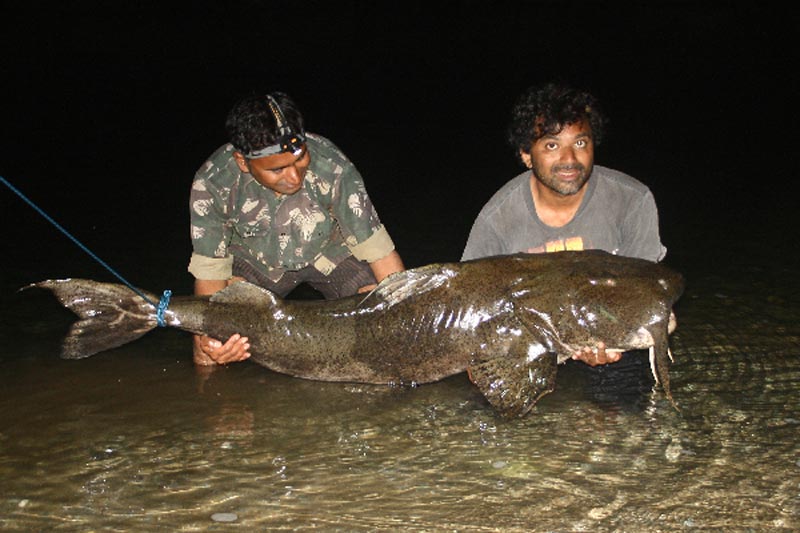Learn The Best Techniques For Drift Fishing
By George Landrail
Drift fishing is an excellent technique for cat-fishing. When you drift fish, you are modeling the natural. Most catfish catch their food when it is slowly drifting amongst the layers of water, the way a drift-fishing bait does. This is precisely the reason why drift fishermen are so successful at snagging the bigger cats like blues and flathead catfish. The fish are really interested when they see drifting bait. “It’s probably another fish,” your average monster cat thinks to himself and gives your bait a bite. The catfish is almost as good as caught when you get it to see your bait as just another floating object.
When you go drift fishing, take a medium to heavy action rod with you. Also take 4/0 Kahle hooks and some cut bait with you. Make sure that the bait is hooked through its skin properly or it might come off too easily. Cut bait works best for larger cats.
It is a well-known fact that most fishermen catch more blues drift fishing than using any other technique of fishing. Just remember to add a slider weight or two to keep the hook below the water. Roll weights are the best kind of weights available. Anything over 1 oz will do just fine.
To drift fish, you need a boat with a trolling motor and a fish locator. A fish locator is a device that tells you about the underwater structures. It also shows the position of fish underwater. You can also find the areas where the catfish mostly hide. A trolling motor can be attached to the rear of your boat to keep it drifting slowly over the water.
Some fishermen study the bottom structure of the pond or lake structure with their fish finders. They carefully note the position of the drop offs and deep pits, if any, where their potential catches might be hiding. This is where the fish finder comes handy. You needn’t go diving or swimming to study the bottom. You can easily study the bottom structure with your fish locator. Sometimes you can also spot fishes in a feeding frenzy in a certain area. You can be sure to find a cat or two in that area. You can drift fish without a fish locator, but it’s good to have one with you. The fish finder costs upward of 90 dollars, so buying one can bleed you dry financially. If you are broke, you can go swimming in the water to check out the bottom structure. Knowing the bottom structure helps you catch more fish.
Trolling motors cost a lot too. A small hand propelled motor may cost you over hundred and fifty dollars. If you can’t afford a trolling motor, rent a paddle boat and paddle out to the spot that seems to attract most fish and sink in your bait. You will definitely get an interested bite or two. If you want more ideas on drift fishing, you could look up my other articles on drift fishing rigs and drift fishing techniques.
You can find more catfishing information here. Click on the link to find a step-by-step guide to cat-fishing and discover the techniques used by pros.
Bait for Catfishing
By Reg Goodman
Whenever possible, one of my favorite things is to escape the hustle and bustle of everyday life and head off fishing. Growing up with brothers provided ample of family time together, often egging each other on to see who would catch the biggest fish of the day and which bait for catfishing was used.
The bait for catfishing often become a big debate and competition in our household, especially when it came to who would lure the big one in. My grandfather always out to prove his philosophy, believed that the best catfishing bait was “natural & alive” – like perch, crawfish or shad, frogs or worms. He preferred using the garden style of worms as he could find them pretty easy himself. He would also sometimes use minnows or grasshoppers and the odd bit of stink bait. He taught us that the catfish possessed a strong sense of smell and using a smelly live bait he would proudly lure them in.
Now my father, however, being a somewhat rebel and always up for the challenge to fish out my granddad, was always experimenting and creating bait for catfishing. He taught us that catfish were mainly scavenger eaters and would just about eat anything long as they didn’t have to travel too far to get it. He would try experimenting with formulas that entailed different combinations from chicken livers, Cheerios, cheese, peanut butter, flour and fish oil or guts. He would take this well mixed up concoction and then freeze it for a couple of days, saying that was part of his “secret sauce” in luring. Depending upon the “formula” some would need a bread wrapped over after being applied to the lure. Especially if he was trying a simple bait technique of marshmallows or a few pieces of corn stuck on the end of each treble hook, with peanut butter to “glue” the bread. He believed that the sweet smell of the corn would work its magic.
We’d head off for a catfishing fest, with various buckets & boxes of live bait and the cooler packed full of homemade bait combinations and spend the day test fishing with the different variations, hopeful of winning. Sometimes my granddad would win out that day and other times my Dad won. The catfish won too, as we always put them back after the inspection and bragging rights. All in all, it provided a lot of fun family memories & planted the seed of pursuit to continually find that perfect bait for catfishing.
Image By Derek Dsouza – http://fishbase.org/photos/UploadedBy.php?autoctr=20020&win=uploaded, CC BY 3.0, https://commons.wikimedia.org/w/index.php?curid=35934658

